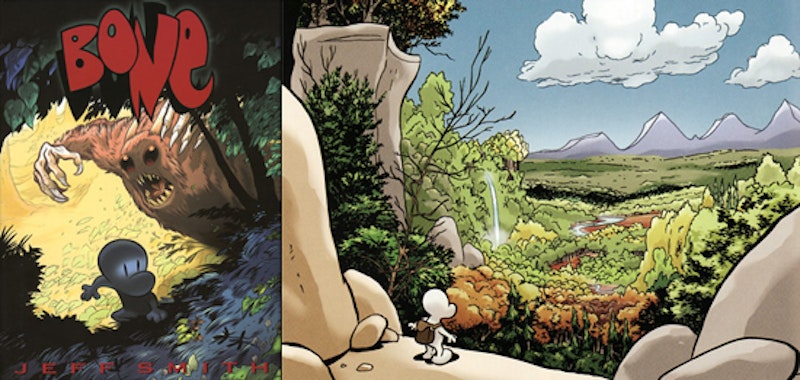Cartoonist Jeff Smith made his fame, fortune and critical reputation with the 55-issue, 1300-page epic Bone. The comic is the story of how three bumbling caricatures got themselves run out of a
U.S.-style small town, found a new, medieval home and overcame their own
weaknesses and bad poetry to save the world. The series ended in 2004 and Smith
wisely refused to dive headfirst into another large project right away.
For a few years, he dabbled. Smith spent time on
various Bone-related projects, including a documentary. He wrote and
drew the four-issue miniseries Shazam! Monster Society of Evil that DC
comics published in 2007. Smith signed on as the designer for the Fantagraphics
collected volumes of his artistic hero Walt Kelly's comic strip Pogo,
and he wrote and drew the short children's graphic novel Little Mouse Gets
Ready.
Then, in 2008, Smith's own Cartoon Books brought out a little book called Rasl. Fans looking for a title that was anything like Bone were surely disappointed. Bone blended comedy and fantasy. It didn't lack for peril, but it was aimed at an all-ages audience. Rasl is a sci-fi noir story and a bit of a head-trip. Its protagonist has heroic qualities, but they're buried pretty damn deep beneath the boozing, whoring, gambling, brawling and inter-dimensional art thieving.
What's more, Smith treats the "science" part of sci-fi as more than window dressing. A good number of pages are devoted to telling the tragic story of inventor Nikola Tesla. Tesla was the man who perfected alternating current, which beat out Thomas Edison's direct current (AC vs. DC) after a bitter and bizarre struggle as the chief way of delivering power. Edison literally staged public electrocutions of animals to demonstrate the supposed dangers of AC. It was from these demonstrations that we got the modern electric chair.
Tesla was also the accidental discoverer of radio who failed to exploit this discovery and serves as the unofficial patron saint of sci-fi nerds everywhere. Rob "Rasl" Johnson is one of those nerds. In 1908, a massive, still-disputed explosion called the Tunguska Event leveled nearly a thousand square miles of wilderness in Siberia. Some of the theories for the explosion are thrown about, then Rasl weighs in: "Me? Even as a kid, I knew Nikola Tesla did it." It was one of his experiments gone wrong, which foreshadows Rasl's own dilemma.
A current heated debate among theoretical physicists and astrophysicists can be stated in layman's terms this way: Is this universe is all there is or are there several universes—"multiverses"—with different physical laws governing them. Rasl explains that Tesla was firmly in the one universe camp but theorized that some of his work on energy pointed the other way. With government backing, he puts his theory to the test and then uses himself as a guinea pig. He finds other universes, all right, but at a great cost to the few people he loves in this world. Worse: reality as we know it is threatened by the military's plans to push the project forward in his absence.
As with Bone, Smith has repackaged Rasl into several formats, from individual comics to oversized collections to standard graphic novel-sized ones. I came to the series with the oversized volumes but would recommend going smaller and cheaper. In any format, the artwork has a dark beauty to it. Smith uses some caricature to bring out the characters' personality traits, but the style is altogether more realistic than his last big project.
The first four pages of the comic are wordless. Silence was a very good artistic choice, because it casts a spell. These pages feature an obviously messed-up, bloodied and perspiring Rasl wandering around a desert in search of something. We are invited to project our struggles onto his, not as an everyman but as someone who will wind up with the weight of our world on his shoulders. As the series comes close to its end, here's hoping he doesn't decide to shrug.
—Jeremy Lott, editor of Real Clear Books and Real Clear Religion, is writing a book about death.

